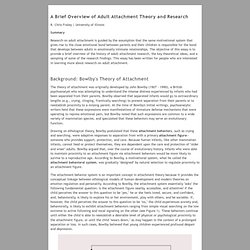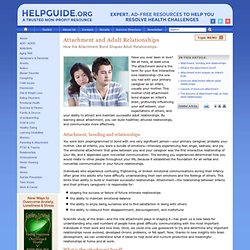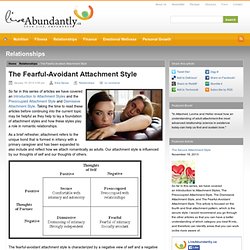

Peter Fonagy, 'Attachment, the development of the self, and its pathology in personality disorders' Introduction by Paolo Migone Peter Fonagy, beside having given important contributions in various areas, is also a very well known researcher in one of the most interesting and promising fields, the research on attachment.

Like Mary Main and other heirs of Bowlby, he continued to explore this line of research, and investigated the concept of "metacognition" (what he calls "reflective self function"), which attracts more and more the attention not only of psychoanalysts but also of researchers of the cognitive field. The Search for the Secure Base: Attachment Theory and Psychotherapy: Amazon.co.uk: Jeremy Holmes.
Adult Attachment and Couple Psychotherapy: The 'Secure Base' in Practice and Research: Amazon.co.uk: Christopher Clulow. Exploring in Security: Towards an Attachment-Informed Psychoanalytic ... - Jeremy Holmes. Winner of the 2010 Goethe Award for Psychoanalytic and Psychodynamic Scholarship!

This book builds a key clinical bridge between attachment theory and psychoanalysis, deploying Holmes' unique capacity to weld empirical evidence, psychoanalytic theory and consulting room experience into a coherent and convincing whole. Starting from the theory–practice gap in psychoanalytic psychotherapy, the book demonstrates how attachment theory can help practitioners better understand what they intuitively do in the consulting room, how this benefits clients, and informs evidence-based practice.
Divided into two sections, theory and practice, Exploring in Security discusses the concept of mentalising and considers three components of effective therapy – the therapeutic relationship, meaning making and change promotion – from both attachment and psychoanalytic perspectives. A Brief Overview of Adult Attachment Theory and Research. A Brief Overview of Adult Attachment Theory and Research R.

Chris Fraley | University of Illinois Summary Research on adult attachment is guided by the assumption that the same motivational system that gives rise to the close emotional bond between parents and their children is responsible for the bond that develops between adults in emotionally intimate relationships. The objective of this essay is to provide a brief overview of the history of adult attachment research, the key theoretical ideas, and a sampling of some of the research findings. Background: Bowlby's Theory of Attachment The theory of attachment was originally developed by John Bowlby (1907 - 1990), a British psychoanalyst who was attempting to understand the intense distress experienced by infants who had been separated from their parents. Individual Differences in Infant Attachment Patterns Ainsworth's work was important for at least three reasons. Attachment and Adult Relationships: Childhood bonding shapes emotional intelligence. You were born preprogrammed to bond with one very significant person—your primary caregiver, probably your mother.

Like all infants, you were a bundle of emotions—intensely experiencing fear, anger, sadness, and joy. The emotional attachment that grew between you and your caregiver was the first interactive relationship of your life, and it depended upon nonverbal communication. The bonding you experienced determined how you would relate to other people throughout your life, because it established the foundation for all verbal and nonverbal communication in your future relationships. Individuals who experience confusing, frightening, or broken emotional communications during their infancy often grow into adults who have difficulty understanding their own emotions and the feelings of others. This limits their ability to build or maintain successful relationships.
Psychotherapy Relationships that Work : Therapist Contributions and ... Attachment to God, Part 3: Attachment Styles and God. From our last post it appears that relationship with God may be fruitfully explored using attachment theory.

However, to do so, we need to explore the literature on what are known as attachment styles. The attachment bond does not simply vary in intensity, going from a strong attachment to a weak attachment. The Fearful-Avoidant Attachment Style. So far in this series of articles we have covered an Introduction to Attachment Styles and the Preoccupied Attachment Style and Dismissive Attachment Style.

Taking the time to read these articles before continuing into the current topic may be helpful as they help to lay a foundation of attachment styles and how these styles play a role in romantic relationships. As a brief refresher, attachment refers to the unique bond that is formed in infancy with a primary caregiver and has been expanded to also include and reflect how we attach romantically as adults.